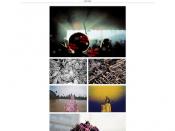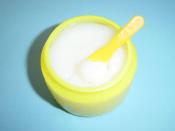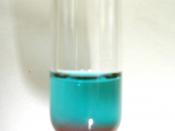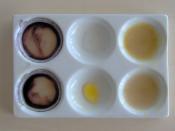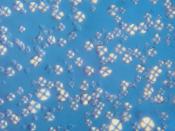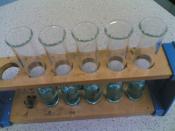Tiltle: What was happened to the bananas?
Objective: To compare the amount of reducing sugars and starch in yellow and green bananas.
Introduction:
Bananas are green in colour and taste flat but after they are harvested and stored for some days, they will turn yellow from green and become sweet.
Hypothesis:
The green banana tasted plain because it contained large amount of starch, while the yellow banana tasted sweet since it contained large amount of reducing sugars.
Biological principles:
Benedict's test for reducing sugar:
Reducing sugars include all monosaccharides (glucose) and some disaccharides (maltose). Benedict's solution contains copper sulphates. Reducing sugars reduce copper(2) ions present in the blue copper sulphate solution to insoluble red brown precipitates.
The initial blue colour of the mixture turns green, then yellowish and may finally form a brick-red precipitates in the presence of reducing sugars. The amount of ppt gives a rough indication of the amount of reducing sugar present.
Iodine test for starch
Starch is slightly soluble in water in which it forms a colloidal solution.
A blue-black colour indicates the presence of starch due to the formation of complex.
Experiment variables
In this experiment, the independent variable is the length of the starch period, hence keep the green banana in the freezer which assumes that storing bananas at the freezing temperature can stop the ripening process. Also keep the other green bananas
in a bell jar can let it become yellow.
The dependent variables are the amount if sugar and starch in the 2 banana samples. The amount of reducing sugars in the 2 samples can be compared by performing the Benedict's test and finding the amount of red ppt in each sample .
The amount of starch in the bananas can be compared by performing the iodine test and finding the intensity of dark blue colour in each sample .
After the experiment, I expect the yellow banana have more reducing sugars but less starch. On the contrary, the green banana contains more starch but less reducing sugars.
Assumptions:
1 The green bananas should have the same amount of starch and reducing sugars before putting in the freezer and the bell jar.
2 All the sweet taste of the yellow banana comes from reducing sugars.
3 During the storage in the freezer, starch in the green banana will not be converted into reducing sugars.
4.All the reducing sugars and starch are all extracted out.
The materials and apparatus:
- yellow banana
- green banana
- Benedict's solution
- Iodine solution
- distilled water
measuring cylinder
dropper
test tube *6
motar and pastle
beaker
filter funnel
muslin cloth
electronic balance
conical flask *2
Procedure:
Remove the green banana peel and use pestle and motar to grind up the green banana sample.
Squash 5g of each sample of green banana in 25ml water to prepare an extract of the tissue.
Filter the mixture by using the triple layer of moist muslin cloth and filter funnel to ensure no solid residue in the conical flask.
Put the filtrate in the two test tubes. Each test tube has 5ml filtrate.
Perform Benedict's test for reducing sugars
Adding 10ml of Benedict's solution into one of the sample solution.
Shaking the mixture well.
Boil the mixture in a hot water bath for 15minutes and then shake it well.
Observe the mixture to see it whether got any changes. Record the result and measure the volume of ppt.But before it, just leave the sample for 5 minutes for the ppt to sink in the bottom of the tube.
Perform iodine test for starch
Add 3 drops of iodine solution to another sample solution.
Test the intensity of dark blue colour.
Repeat step 1 to 6 by using a half-ripe banana and a ripe banana.
Compare the results of the food tests for these three samples
Tabulate the results.
Results (because the table has some problems in uploading, hence I won't use any table )
Benedict's test:
Amount of precipitate in raw: 0.45cm
Amount of ppt in half-ripe: 0.6cm
Amount of ppt in ripe:0.8cm
Iodine test:
Colour of iodine test in raw: dark blue
Colour of iodine test in half-ripe: blue
Colour of iodine test in ripe: very pale blue
Discussion:
In the experiment, we can compare the amount of reducing sugar and starch in the sample. In the Benedict's test, the volume of ppt in ripe banana sample is the largest, ppt in the raw banana is is the smallest, ppt in the half ripe banana is greater than the raw banana's but smaller than that of ripe banana.
In the iodine test, the colour of the sample shows that the raw banana has the largest amount of starch. The raw banana has the smallest amount of starch. The amount of starch in half-ripe banana is greater than that of ripe banana but smaller than that of the raw banana.
In the Benedict's test, we can use another means to show the result. After having a hot water bath,we can remove the liquid solution form the sample. Then we put it onto the water bath with evaporate dish in order to remove the water in the ppt. After that we weight the ppt.
In the iodine test, the result is not accurate enough because the result is determined by our bear eye. We can use another method to show the result more accurately. First, we can use the colorimeter to determine the colour intensity of the blue colour of the sample. Second, we can use the same amount of sample and drop the iodine solution until their colour intensity are the same. At the same time, we can measure the drops of the iodine we have added. The larger amount of drops used that means more starch is present.
The error in this experiment is that one banana cannot represent all banana in the world.
The amount of Benendict's solution added must be far in excess of the sample solution. Because that is required oxidize the amount of reducing sugar present in the raw banana. It is because after oxidizing sugars that are originally present in the raw banana, no excess Benedict's solution is left over to react with newly formed reducing sugars. Hence, "the amount of reducing sugars present in the sample are the same" THIS STATEMENT IS NOT TRUE.
Conclusion:
The raw banana has more starch than that of ripe banana. The ripe banana has more reducing sugar than that of raw banana. So the ripe banana tastes sweet and the raw banana tastes flat.
.
